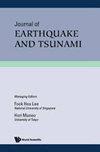使用帝国主义竞争优化算法的脉冲式地面运动定量建模
IF 2.1
4区 工程技术
Q2 GEOCHEMISTRY & GEOPHYSICS
引用次数: 0
摘要
在定量和定性模型中,对类脉冲地震动的主导速度脉冲的研究越来越受到重视。采用人工试错法拟合实际记录和模拟脉冲的时程和响应谱,获得了这些模型的脉冲参数。本文采用数学模型和帝国主义竞争算法(ICA)来克服以往研究的局限性。为此,将目标函数定义为实际记录和模拟脉冲的时程和响应谱的范数偏差。所提出的方法能够识别和提取任何脉冲样记录的主导脉冲,并且由本研究中使用的91个脉冲样记录组成。在所有91条记录中,实际记录和提取脉冲的时间历史和弹性响应谱的一致性最高。以1999年集集地震为例,利用提取的脉冲生成人工脉冲记录。研究了SAC工程中三层框架在生成记录作用下的动力响应。结果表明,该方法可用于类脉冲地震动的参数化研究。本文章由计算机程序翻译,如有差异,请以英文原文为准。
Quantitative Modeling of Pulse-Like Ground Motions Using Imperialist Competitive Optimization Algorithm
Increasing attention in quantitative and qualitative models has been paid to the dominant velocity pulse of the pulse-like ground motions. Manual trial and error approach for fitting of time history and response spectrum of the actual record and simulated pulse has been employed to obtain pulse parameters of these models. In this study, a mathematical model and the imperialist competitive algorithm (ICA) are used to overcome the limitations of the previous studies. For this purpose, an objective function is defined as the norm deviation of the time history and response spectrum of the actual record and simulated pulse. The proposed approach is capable of identifying and extracting the dominant pulse of any pulse-like record, and consists of 91 pulse-like records used in this study. In all of 91 records, the highest accordance with time history and elastic response spectrum of actual records and extracted pulses is achieved. As a case study, the extracted pulses of the 1999 Chi-Chi earthquake are used to generate artificial pulse-like records. The dynamic responses of the 3-story moment frame in SAC project subjected to generated records are investigated. The results show that the proposed approach can be used in parametric studies of pulse-like ground motions.
求助全文
通过发布文献求助,成功后即可免费获取论文全文。
去求助
来源期刊

Journal of Earthquake and Tsunami
地学-地球化学与地球物理
CiteScore
2.60
自引率
13.30%
发文量
38
审稿时长
>12 weeks
期刊介绍:
Journal of Earthquake and Tsunami provides a common forum for scientists and engineers working in the areas of earthquakes and tsunamis to communicate and interact with one another and thereby enhance the opportunities for such cross-fertilization of ideas. The Journal publishes original papers pertaining to state-of-the-art research and development in Geological and Seismological Setting; Ground Motion, Site and Building Response; Tsunami Generation, Propagation, Damage and Mitigation, as well as Education and Risk Management following an earthquake or a tsunami.
We welcome papers in the following categories:
Geological and Seismological Aspects
Tectonics: (Geology - earth processes)
Fault processes and earthquake generation: seismology (earthquake processes)
Earthquake wave propagation: geophysics
Remote sensing
Earthquake Engineering
Geotechnical hazards and response
Effects on buildings and structures
Risk analysis and management
Retrofitting and remediation
Education and awareness
Material Behaviour
Soil
Reinforced concrete
Steel
Tsunamis
Tsunamigenic sources
Tsunami propagation: Physical oceanography
Run-up and damage: wave hydraulics.
 求助内容:
求助内容: 应助结果提醒方式:
应助结果提醒方式:


